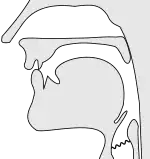| Voiced labiodental plosive | |
|---|---|
| b̪ | |
| ȸ | |
| IPA Number | 102 408 |
| Encoding | |
| Entity (decimal) | b̪ |
| Unicode (hex) | U+0062 U+032A |
| X-SAMPA | b_d |
| Braille | |
The voiced labiodental plosive or stop is a consonant sound produced like a [b], but with the lower lip contacting the upper teeth, as in [v]. This can be represented in the IPA as ⟨b̪⟩. A separate symbol that is sometimes seen, especially in Bantu linguistics, but not recognized by the IPA, is the db ligature ⟨ȸ⟩.
The voiced labiodental plosive is not known to be phonemic in any language. However, it does occur allophonically:
In the Austronesian language Sika, this sound occurs as an allophone of the labiodental flap in careful pronunciation.
The XiNkuna dialect of Tsonga has affricates, [p̪͡f] (voiceless labiodental affricate) and [b̪͡v] (voiced labiodental affricate).
Features

Features of the "voiced labiodental stop":
- Its manner of articulation is occlusive, which means it is produced by obstructing airflow in the vocal tract. Since the consonant is also oral, with no nasal outlet, the airflow is blocked entirely, and the consonant is a plosive.
- Its place of articulation is labiodental, which means it is articulated with the lower lip and the upper teeth.
- Its phonation is voiced, which means the vocal cords vibrate during the articulation.
- It is an oral consonant, which means air is allowed to escape through the mouth only.
- It is a central consonant, which means it is produced by directing the airstream along the center of the tongue, rather than to the sides.
- The airstream mechanism is pulmonic, which means it is articulated by pushing air solely with the intercostal muscles and abdominal muscles, as in most sounds.
Occurrence
| Language | Word | IPA | Meaning | Notes | |
|---|---|---|---|---|---|
| Danish | Standard[1] | ved | [b̪̆e̝ːˀð̠˕ˠ] | 'know(s)' | Rather short; also described as an approximant [ʋ]. A rare alternative is a fricative [v].[2] See Danish phonology. |
| English | subversive | [sʌb̪ˈvɚsɪv] | 'subversive' | Common allophone of /b/ before the labiodentals /f/ and /v/ (although it is also possible for the labiodentals to shift to bilabial [ɸ] and [β], respectively, instead). | |
| Ibanag | bavi | [bab̪ᵛiː] | ˈpig/pork' | Slightly affricated; allophonic variant of /v/ for some elderly speakers, especially those who lack front teeth. May be a flap /ⱱ/ instead. | |
| Sika | Allophone of /ⱱ/ in careful pronunciation. | ||||
| Slovene | ob vodi | [ob̪‿ˈʋɔ̀ːdí] | 'by the water' | Allophone of /b/ before /f, ʋ/. See Slovene phonology. | |
Notes
- ↑ Basbøll (2005), p. 27.
- ↑ Basbøll (2005), pp. 27, 66.
References
- Basbøll, Hans (2005), The Phonology of Danish, OUP Oxford, ISBN 0-198-24268-9
External links
This article is issued from Wikipedia. The text is licensed under Creative Commons - Attribution - Sharealike. Additional terms may apply for the media files.